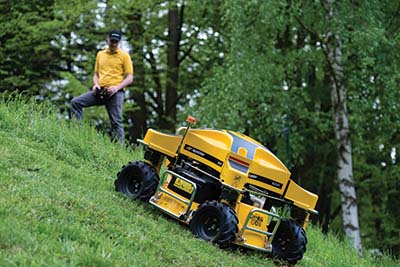A big commercial mower is an awesome thing to behold; a magnificent piece of machinery, made of many hundreds of pounds of metal, with sharp blades that whirr at very fast speeds. When all that mass and cutting power is unleashed on an expanse of turf, a beautifully mowed landscape is the result.
When it’s unleashed on human flesh, however, grave injury can follow. And so, we read stories like this all too frequently: “Landscaper seriously hurt after riding mower flips.” Accidents like that happen when someone is mowing a slope with a zero-turn rider, and the mower flips over and pins him down. That alone can be a paralyzing or even fatal event. When it happens in a body of water, even a shallow one, the result is nearly always tragic. Yet this sort of accident is completely preventable.
A rollover isn’t the only serious accident one can experience while working with commercial mowers. Fingers and hand amputations, eye injuries and burns are also common. These too, are avoidable.
Training
How can accidents that cause pain, suffering and loss of productivity be prevented? One word: Training. People on mowing crews work only as safely as they’ve been trained to. A good, comprehensive program of instruction is absolutely essential, whether it’s done formally in a classroom setting, out in the field or a combination of both.
A good, comprehensive program of instruction is absolutely essential, whether it’s done formally in a classroom setting, out in the field or a combination of both.
At Corion Landscape Management Inc., Ferndale, Washington, the onboarding process for new employees starts by going through the training provided by Greenius, the London, Ontario-based company that has a number of training programs geared towards green industry personnel.
“They watch some online videos and then take tests on what they’ve learned,” says President David Arnold. “Mower safety is part of that. The second step is hands-on training from the crew lead in the field. We go through that process all the way from how you properly start the equipment to how you stop it and everything in between.”
“At some point, once we believe they’re fully trained, they then have to go through a certification process. So, they get some initial training, some teaching out in the field, and then they have to prove that they’ve reached the mark.”

Terry Minerd is operations manager at Linnemann Land Care and Landscaping Inc., Columbia, Illinois. Training there starts by going through a booklet with all the new hires. “Then we take them out in the field,” says Minerd. “We work with them on the machines they’re going to use, make sure they know what they are doing and what the safety rules are for those pieces of equipment.”
Because people are often injured while cleaning clogs out of mower decks, Linnemann has a rule about making sure the mowers are completely turned off and the keys are out of the ignition before reaching a hand into the deck. “If it’s really, really clogged up, we ask them to pull apart the spark plug wire so that it can’t start.”
Commercial mower manufacturers are well aware of the value of this sort of training. Ted Walker, director of engineering at Walker Manufacturing, Fort Collins, Colorado, says, “The most important element for mower safety is operator education. Most mowing-related injuries are the result of unsafe operating practices; things that are warned against in operator’s manuals and on equipment safety labels.”
Walker points out that there is a wealth of safety information to be learned in the manuals and other materials provided with any mower — but first, you have to read it. “Too often, the operators never see the manual or receive little training on how to operate the mower safely.”
Saying “I lost the manual” isn’t a good enough excuse anymore. Most manufacturers have downloadable operator’s manuals on their websites or will send you a replacement paper one free of charge.
Training also means retraining. Anyone can forget something or get careless. Periodic refreshers are needed, even for old-timers. A mandatory safety meeting that every person on the mowing crew must attend before the start of the season, no matter how experienced someone may be, would reinforce the message that safety is a high priority at your company. Weekly tailgate meetings should cover safety topics as well.
“The most important element for mower safety is operator education.” – Ted Walker, Walker Manufacturing
“Put those gloves back on, please!”
When someone joins the staff at Chapel Valley Landscape Co., Woodbine, Maryland, he is given some special items. “Of course, we issue personal protective equipment: eye protection, ear protection,” says Safety and Compliance Manager Bruce Parks. “We give them gloves and encourage them to wear them.”
Setting rules is one thing; getting people to comply with them is another. Crew leaders can get pushback on something as simple as keeping gloves on. “Some of the guys complain about wearing gloves, because it’s harder to manipulate some of the controls and stuff,” says Parks. “But they need to wear their PPE at all times, and the gloves are part of it.”
Parks mentioned the Occupational Safety and Health Administration’s “competent person” rule. “Every job site has to have a competent person present. OSHA describes that as someone who can not only recognize any hazard but has the authority to stop the job and correct it. We try to drive that home with our supervisors.”
But, as he puts it, “People are people. Sometimes I’ll be on a job site and I’ll see a guy doing something hazardous or not wearing his PPE. I’ll have to go to that supervisor and say, ‘This is your job. Why aren’t you doing your job?’ Very often, he’ll say, ‘That guy won’t listen to me.’ Well, then that person needs to get a written warning. If you’ve ever supervised people, you know that it’s just a never-ending battle to try to keep them in line.”
Sometimes, people have worked at other companies where supervision was lax and fell into bad habits, such as zip-tying down throttles or otherwise defeating operator presence controls. “On the older mowers, you could disable that stuff,” says Parks. “Back in the old days you could tie a bandana around the presence control that was on the handle. Those controls are so integrated now that it’s really difficult to disable them.”
To get people to comply with safety rules, some companies offer incentives, such as end-of-season bonuses for maintaining a safe work record. Having negative consequences for breaking safety rules works too. At Chapel Valley, “if you damage a piece of equipment or if you’re negligent and you damage somebody’s property with a mower or a vehicle, the first time, you’ll get a warning, and you will have to pay up to the first $250 of the damage,” says Parks. “The second time, you’ll get another warning, but you’ll pay up to $500. The third incident within a three-year period would be the same fine and/or potential termination.” Serious accidents involving injury will require a drug test.
Despite those consequences, Parks says it’s still sometimes quite difficult to keep safety rules enforced. “Sometimes people will say, ‘Well, I’m going to go to work for your competitor because they’re not going to charge me $250 just because I did something foolish.’” And with today’s labor shortage, there may be a tendency to keep an unsafe operator on the job because a company simply doesn’t have anyone to take his place.
What does OSHA say?
The Occupational Safety and Health Administration has some guidelines on riding-mower safety. This statement appears on the webpage titled “Dangers of Rollovers of Riding Mowers,” (www.osha.gov/dsg/riding_mowers/index.html) “Employers are responsible for providing workers with training before they can operate any lawn mowing equipment. Training ensures that each operator is competent to operate a riding mower safely. It must be provided in a language and vocabulary that workers can understand.” The list of topics that should be covered in training sessions includes:
- How to properly use the ROPS system rollbars, guards, seat belts and shields, and that they are to be used at all times
- Surveying the terrain for obstacles or hazards in the path before beginning to mow
- Reading and understanding the owner’s manual
- Decreasing speed when the mower is traveling down slopes or around sharp corners
- Being alert when backing up or working in low-light conditions
- Not mowing from side-to-side when operating mowers on unlevel or sloped ground
- Always mowing slopes in the up-and-down direction
- A review of stability and rollover hazards associated with operating riders on loading ramps, wet surfaces and areas near dropoffs, retaining walls, embankments and anywhere there is or could be water
- To use all required personal protective equipment at all times, including hearing and head protection, safety glasses and work boots, and to avoid wearing jewelry and loose-fitting clothing that can easily become entangled with moving parts
- Never carry passengers on a riding mower
- Always start the mower from the driver’s seat, never while standing beside it. Keep both feet on the machine at all times while it is on and running
- Never place the mower in motion until a worker is ready. Putting the mower in gear unintentionally could cause it to jerk forward without any warning
- Never mount or dismount a mower while it is running, as there may be enough space for an operator’s toes to pass under the mower housing and be struck by the blade. Perform proper shutdown procedures before dismounting
- Never stop or start a riding mower suddenly when it is going uphill or downhill
- Avoid all sudden starts, stops or turns
Preventing rollovers
All of the mower manufacturers are aware of the rollover problem. Most rider mowers have a rollover protection structure, more commonly known by its acronym “ROPS.” It consists of a roll bar that extends above the operator and a seat belt. The rollbar is often called “the ROPS,” but the seat belt is also an integral part of the system. “For the ROPS system to be effective, the rollbar must be in the raised position (many roll bars are hinged and can be lowered to allow the machine to fit into enclosed trailers or under other areas with low clearance), and the operator must use the seat belt,” says Walker.
“In the case of machine rollover, the seat belt will retain the operator within the protective zone created by the ROPS,” says a spokesperson for John Deere, Moline, Illinois. “Lower a folding ROPS only when absolutely necessary and then immediately return it to a raised position. If a ROPS rollbar is folded down, do not wear the seat belt. There is no rollover protection when a ROPS rollbar is in the down position.”
ROPS rollbars are often put in down position to go under a low-hanging tree branch — and left there for the rest of the mowing session or the day. That’s where crew leaders, or whoever is in charge of enforcing safety rules, must keep a close watch to make sure people are following the company’s safety edicts — and enforce consequences for those who aren’t.
Corion required rollbars be kept in the up position. “The only exception is when they’re underneath a tree on flat ground,” says Arnold. “However, once they’ve mowed around that tree, they’re required to put the rollover bar back in place and it is to remain there at all times.”
Of course, it’s best to prevent rollover accidents from happening in the first place. Walker says, for zero-turn style machines, this means using extra caution when operating on slopes, and never operating in areas where a loss of traction could result in the mower going over a steep embankment, a retaining wall, or into a pond or lake shoreline.
In fact, he cautions that rider mowers should never be operated close to embankments or retaining walls, even if the areas are flat, as embankments or retaining walls can give way and result in a rollover.
“One of our branches is in Norfolk, and there’s water all over the place,” says Parks. “I’ve been in some of their meetings, and one of our managers there constantly talks about how you need to be really, really careful when you’re on a slope anywhere near water where you could possibly slide in.”
OSHA’s rollover prevention page states that “the safe operation of a riding mower is similar to the safe operation of a motor vehicle — drive defensively and expect the unexpected. Employers should train workers to operate the mower as if there were no ROPS in place. A protective structure is not unlimited in its ability to protect the operator.” And finally, it contains a statement that you might consider emblazoning on a big sign that everyone can see every day: “Agility and quickness do not ensure invincibility.”
Hitting the slopes more safely
String trimmers are the usual go-to for mowing steep slopes, but it’s time- and labor-intensive. Some mowers are designed just for this purpose. The tractor-style rider mowers from Ventrac, manufactured by Venture Products Inc., Orrville, Ohio, can mow slopes as steep as 30 degrees. All the units have low centers of gravity, and some have dual wheels.

Still another alternative is to use an unmanned slope mower such as one of the units made by Spider. These units are able to mow slopes as steep as 55 degrees. They were invented in 2003 by a road-building contractor in the Czech Republic. Part of his contract was to maintain the steeply banked roadsides he’d just paved for a year afterward. Unable to find the right tool, he went out to his garage and, with the help of a cousin, built the first unit from scratch. He realized he had something marketable, and in 2004 he brought out the first production model.
The mowers have health and safety benefits beyond avoiding rollover accidents. “In Europe, the regulations are quite strict regarding exposure to hand-arm vibrations, and how long you can use certain machines,” says Peter Driver, Spider’s public relations manager. That’s made them highly marketable in Europe. In the U.S., the mowers have been purchased by energy companies with large solar farms and the Daytona International Racetrack among others.
Spider’s mowers are operated via a remote-control console similar to a drone’s, with the person controlling it standing safely a few feet away. Why remote control and not robotics? “Just imagine a robotic mower working on the side of a freeway, following its programmed pattern,” says Driver. “What happens when there’s a wreck on the freeway and a fender or wheel goes flying into the long grass? The mower is going to hit that object and probably be destroyed, or knock that object back into the road, possibly causing more accidents.”
If you mow lots of steep slopes, you might consider buying a dedicated slope mower from Ventrac www.ventrac.com or Spider, which has U.S. distribution through a company called Slope Care in Orlando, Florida, www.slopecare.com.
Missile launch
Rollovers aren’t the only hazards involving mowers. Rocks or hunks of debris can get picked up by mower blades and hurled at buildings, vehicles and people. “That happened recently, at a large shopping-mall project we were doing,” says Parks. “I got a call from the client’s property manager saying, ‘Your guys were out here mowing, and a transit bus was going by and a rock shot out from one of the mowers and hit the bus.’” “A couple weeks later, we were at that same site. I said to the grounds manager, ‘You need to see what’s going on here.’ I took him to where the accident happened, showed him how the turf was in really poor shape — the grass had deteriorated and the ground was full of rocks. Nobody had recognized that the quality of the turf was bad enough that it could potentially cause debris to be thrown.”
“So we told the client, ‘Guess what — we’re not mowing there anymore. We’ll remediate that area, mulch it and resod it, but we can’t mow it anymore because we’d be putting the public at risk.’” Parks says he tells his company’s mowing crew members not to be afraid to speak up when they run into this type of thing, to feel free to approach a manager and say, “‘We can’t mow that area, it’s too dangerous.’ That’s where you need your ‘competent person’ to step up and make sure the client understands.”
The bus incident could have been so much worse. A missile of any kind flying out of a mower is like a stray bullet; debris can be propelled outwards at speeds as high at 200 mph. Any object zooming that fast could take out someone’s eye or cause other serious injuries.
This is why there are guards on discharge chutes. So why do these accidents happen? The chutes can get clogged, especially when mowing wet grass, and operators will take them off so they don’t have to keep stopping to clear them. This is a dangerous practice, and not just car windows are at risk when it is done. Anyone walking, biking or driving by could be hit.
“Bystanders, especially children, can be hurt by flying debris,” says Walker. “Young children should be taught to stay well away from mowers,” Walker says.
Thankfully, defeating or disabling safety features on mowers is getting harder all the time, thanks to the companies that make them. “Our mowers are designed so that the discharge chute will automatically return to the down position unless you are physically holding it up — which you’re not supposed to do,” says Seth Hershberger, product safety engineer at Excel Industries Inc., Hesston, Kansas, the manufacturer of Hustler and Big Dog mowers.
Finally, there’s nothing inherently dangerous about commercial mowers; when used properly, they are like any other tool.
If your company is in need of a training program, you are in luck. Excellent training materials are available on OSHA’s website at www.osha.gov/SLTC/landscaping/safetyprograms.html and from the National Association of Landscape Professionals’ Safe Company Program, available at www.landscapeprofessionals.org/nalp/nalp/safety-risk-management/safe-company-program.aspx. You can also hire a company like Greenius to handle your company’s training program. Here’s to many safe seasons ahead!





